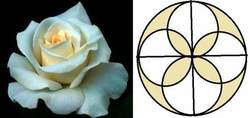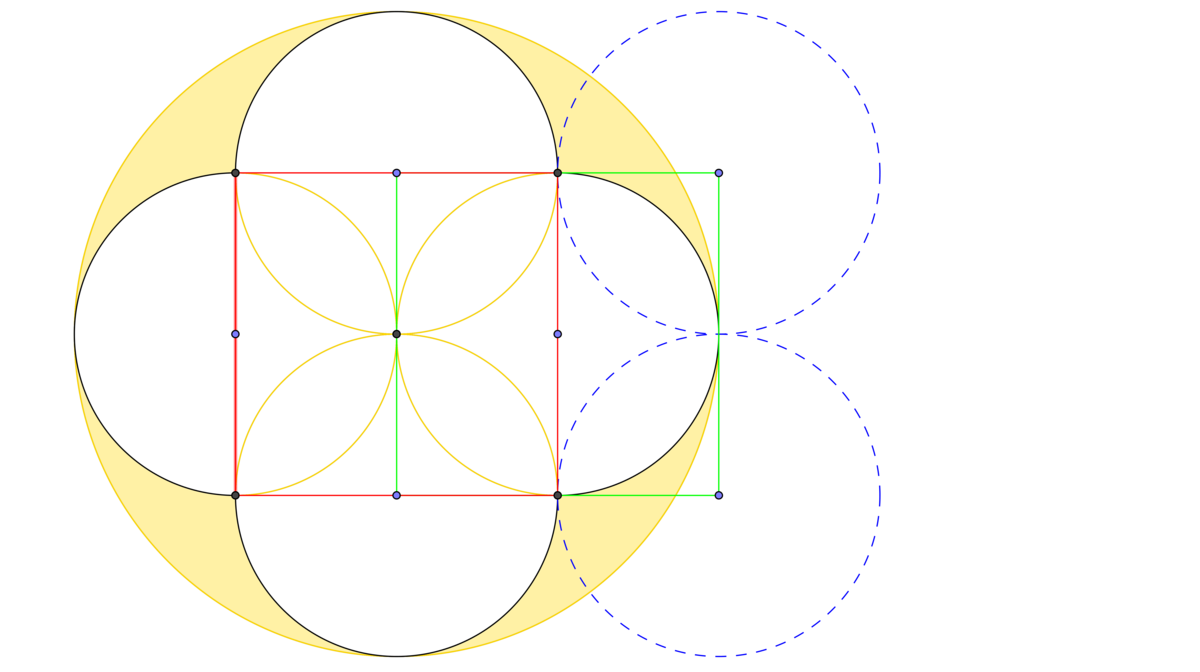A Rose For My Mother
 Mandy tried to draw a rose for Mother's Day using many circles. He started out with a large circle of radius 7cm, and then drew 4 smaller circles in a symmetrical way. He then colored in parts of the flower in yellow. What is the area
(
in
cm
2
)
of the yellow part?
Mandy tried to draw a rose for Mother's Day using many circles. He started out with a large circle of radius 7cm, and then drew 4 smaller circles in a symmetrical way. He then colored in parts of the flower in yellow. What is the area
(
in
cm
2
)
of the yellow part?
The figure is completely symmetrical.
The figure is not drawn to scale.
Take
π
=
7
2
2
.
The answer is 56.
This section requires Javascript.
You are seeing this because something didn't load right. We suggest you, (a) try
refreshing the page, (b) enabling javascript if it is disabled on your browser and,
finally, (c)
loading the
non-javascript version of this page
. We're sorry about the hassle.
10 solutions
I didn't understand how Area of part A= S/2 - 7/2 x 7/2.
If you connect the centers of the circles to the intersection point of the two circles you get a square.Now if you look at the square carefully you will find that it is made of the quadrants of the two circles.These two quadrants make up a semicircle.
Now we can say that the area of the square =Area of semi circle-Area of part A.
From this you can get the area of part A
Clearly understood?
The area of the larger circle are
7
2
2
x7x7=154 sq.cm
The area of the smaller circle are
7
2
2
x
2
7
x
2
7
=
2
7
7
sq.cm
Find the area of each yellow shaded part in smaller circle by calculating :
(
2
7
x
2
7
)
−
2x
(
2
7
x
2
7
−
4
1
x
2
7
7
)
= 7 sq.cm (I don't know how to explain this without picture)
2
7
is radius for smaller circle.
So, the area of not yellow shaded in each smaller ciclre are
2
7
7
- (2x7) =
2
4
9
Thus, the area of the part shaded in yellow are 154 - 4x
2
4
9
=56 sq.cm
How was the area of smaller circle 7/2? ?
Log in to reply
The area of the smaller circle are 2 7 7 sq.cm. The radius are 2 7 cm
Lot of people are approximating pi to the worst fraction of 22/7. pi should always be given little more respect. In extreme necessity one can approximate pi to 355/113 and nothing else. Long live pi !!!
Let O, O1, O2, P, R, r be:
O: center of major circle;
O1: center of the minor circle at east;
O2: center of the minor circle at north;
P: intersection point between Circle(O1, r) and Circle(O2, r);
R: radius of the major circle;
r: radius of the minor circles;
R = 7cm;
r = R/2 = 3.5cm;
π ≈ 22/7;
Find value of area of yellow - green Ay shaded area;
Ac(O,R) = πR^2;
Ac(O1,r) = πr^2 = π(R/2)^2 = πR^2/4;
Area White = Aw;
Area Yellow = Ay;
Ay = πR^2 - Aw;
Aw/8 = Ac(r)/2 - 2As(OP):
2As(OP) = Area of surface of intersection between C(O1, r) and
C(O2, r);
As(OP) = Ac(r)/4 - At(OO1P);
At(OO1P) = |OO1||O1P|/2 = r^2/2;
Aw/8 = Ac(r)/2 - 2(Ac(r)/4 - r^2/2) = r^2;
Aw = 8r^2 = 8(R/2)^2 = 8R^2/4 = 2R^2; (Area of a square of side
√2R);
Ay = πR^2 - 2R^2 = R^2(π - 2);
Ay ≈ R^2(22/7 - 2) =7^2 x 8/7 = 7 x 8 = 56
The area of the bigger circle is: 7 2 2 × 4 9 = 1 5 4
The area of one of the smaller circles: 7 2 2 × 2 7 × 2 7 = 3 8 . 5
Then we need to calculate the area of the intersections of the smaller circles:

As the image above we can imagine two circles tangent to two of the small circles. We connect the centers of the four circles forming a square (In green), clearly the area of the star of four spikes formed inside the circle equals to: Area of the green square minus Area of a small circle. Then its area is:
4 9 − 3 8 . 5 = 1 0 . 5
We can observe in the image that four of the intersections are formed inside the circle, so the area of the four intersections is:
4 9 − 2 ( 1 0 . 5 ) = 4 9 − 2 1 = 2 8
Now, the area of the four circles without it's intersections is:
4 ( 3 8 . 5 ) − 2 8 = 1 5 4 − 2 8 = 1 2 6
Finally, the area in yellow it's:
( 1 5 4 − 1 2 6 ) + 2 8 = 5 6
you can draw a square in the center by the joining the diameters of the small squares. From this subtract the area of 1 small circle and multiply the answer by 2. You now have the area of the 4 leaf shaped objects. Since the shaded portions all have a ratio of 1:1 multiply the area of one leaf shaped object by 8 and you get 56.
From solving you can subtract the are of 2 leaf shapes from a circle and multiply by 4. this gives you the total unshaded area. Subtracting the 4 leaf shapes from the remainder 56, you can note that each portion has a 1:1 area ratio.
Moderator note:
Great observations with the middle.
How do you know that the shaded portions all have a ratio of 1:1?
For the area of the inner yellow bits (A): Area of a segment = area of sector - area of isoscoles triangle = (πr^2)*(θ/2π) - 1/2 r^2 sinθ=1/2 r^2(θ-sinθ) θ=π/2 and there are 8 segments, so A=4r^2(π/2-1)
For the area of the outer yellow bits (B): We find the area of the big circle, subtract the area of the 4 smaller circles, then add on the area of the inner bits because they were counted twice when subtracting the smaller circles. So B=πR^2-4πr^2+A But R=2r, so B=4πr^2-4πr^2+A=A
So the total area = A+B=2A=8r^2(π/2-1) Now sub in r=3.5cm and get a final answer of 98(π/2-1)=55.9380400...=55.9cm^2
OR
YOU CAN USE INTEGRATION ALSO AND THE OUTER PART AREA IS EQUAL TO INNER PART
22 7/16 - 49/8 = 3,5 3,5 2= 7 cm² (Área da intersecção entre dois círculos no primeiro quadrante) 22/7 * (7²/2³) - 7 = 12,25 => 2 (12,5) = 24,5 => 24,5 + 7 = 31,5 [22/7 * (7²)]/4 (área do 1º Quadrante) - 31,5 = 7cm² 7 4 + 7*4 = 56
You can replace the yellow areas, so you will have a white square inscribed in the big circle. Then the yellow area is equal to the diference between the circle's area and the square's area, this is 154-98= 56.
Consider smaller circle first and find the area of quarter circle (9.625 sq cm). Find the area of the triangle that forms part of this quarter of the circle (6.125 sq cm). Now subtract the area of the triangle from that of the sector, you get the area under the chord (3.5 sq cm). Double this last are and you get the inner leaf shaped shaded area (7 sq cm). Find the unshaded area of smaller circle subtracting the 2 leaf shaped shaded areas (24.5 sq cm). 4 times of 24.5 (98 sq cm) gives total inner unshaded area. Find the area of the larger circle (154 sq cm). Subtract 98 from 154, we get total shaded area (56 sq cm).
I find a shaded area of quarter of the rose. Then multiply by 4 I find an answer 56. How I make this: First I find the area where two small circles with radii 2 7 are overlapped . I named it C. I find that an area of C is equal to S C = 2 ( 4 π ( 2 7 ) 2 − 2 ( 2 7 ) 2 ) = 2 2 7 = 7 . The area outside shaded area ( named it D) is the area of the quarter larger circle minus the area of one smaller circle plus the shaded area C: It all equal to 7, because S D = 4 7 2 π − ( 2 . 2 7 2 π − 7 ) = 7 . That is mean S c + S d = 14. Then from symmetry I find that 4. 14 = 56 is all shaded area.
First find the area of the petals in the smaller circle with radius of 3.5 cm = 2 (area of quadrant - area of triangle ) = 2( pi x 3.5^2/4 - 3.5x3.5/2) = 6.9923 . Compute the unshaded area in the smaller semi-circle = pi/2 x 3.5^2 -6.9923 = 12.25. Compute for the un-shaded area of the bigger quadrant = pi/4 x 7^2 - 2 x12.25 - 6.9923 = 6.9923..Therefore total colored area = 6.9923 x 4 + 6.9923 x 4 = 55.938 approximately 56 cm^2.......
Log in to reply
@Mauricio Jadulos can you explain with the reference of the picture. i am little confused.
Log in to reply
what about?
Log in to reply
@Mauricio Jadulos – 2 (area of quadrant - area of triangle ). in this what is 2. another one is here about the 4. (2( pi x 3.5^2/4 - 3.5x3.5/2).
Log in to reply
@Sri Prasath – If you look at the picture, the four intersecting circles of radius 3.5 cm produces 8 circular segments all in all or only 2 circular segments between 2 smaller circles, hence you have to multiply it by 2 the net area bounded by these 2 smaller circles ( Area of the quadrant less that of the triangle.) . Of course you divide the area by four since it is a circular quadrant, meaning 1/4 the area of the circle.. You can solve also the area of the circular segment using this formula A = 1/2 r^2( theta - sine theta) where theta is the central angle and in this case it is 90 degrees or pi/2 radians and sine 90 is equal to 1...
Log in to reply
@Mauricio Jadulos – oh great man. i am expecting this only thanku very much....
In the condition above it's recommend to substitute pi with 22/7. Then S = 56 sm^2
i cannot explain how i complete this question but our ans is same
I think that the answers are the same. too!:) It's all right!:)
what abt he overlapping arcs
How I can upload pic?
Area of the larger circle= 7 2 2 x7x7=154sq.cm (B)
Area of each of the smaller circles= 7 2 2 x 2 7 x 2 7 = 2 7 7 (S)
Area of the overlapping region=A(say)
Area of the shaded region=B-(4S-4A)+4A=B-4S+8A
Area of part A= 2 S - 2 7 x 2 7
= 4 7 7 - 4 4 9
= 4 2 8
Area of the shaded region=B-4S+8A
=154-4x 2 7 7 +8x 4 2 8
=56sq.cm
The solution could be better understood by a pic but I don't know how to upload it.